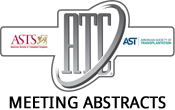2018 American Transplant Congress
A Phase-I Clinical Trial of Donor-Derived MIC Cell Infusion for the Induction of Donor-Specific Hyporesponsiveness after Living Donor Kidney Transplantation (TOL-1 Study)
MIC cells are donor-derived monocytes that gain immunosuppressive properties after incubation with the proliferation inhibitor mitomycin C.PBMCs were harvested from living donors by leukapheresis and…2018 American Transplant Congress
Enhancing Coordination across Healthcare Settings through a Web-Based Transplant Referral Exchange (T-REX) Platform
1Emory University, Atlanta, GA; 2Apex Health Innovations, Simi Valley, CA.
Background: Communication between dialysis and transplant centers with regard to end-stage renal disease patient information throughout the transplant process is administratively intensive. We collaborated with…2018 American Transplant Congress
Interferon-b Promotes Regulatory T Cell (Treg) Induction and Prolongs Allograft Survival
Background: Interferon-b (IFNb), a type I interferon with antiviral and pro-inflammatory activity, has been used as an immune modulatory treatment of multiple sclerosis (MS). The…2018 American Transplant Congress
Positive Relationship between Transplant Center Volume and Utilization of Hard to Place Liver Allografts after Late Declines
Given ongoing waitlist mortality and the high rates of liver discard in the US we wanted to investigate late declines (LD), and very late declines…2018 American Transplant Congress
Immunity and Tolerance after Bilateral Orthotopic Lung Transplant (BOLT) in Tandem with a CD3+/CD19+ Depleted Vertebral Bone Marrow Transplant (BOLT+BMT) from 1 of 8 HLA-Matched Cadaveric Donors
Primary immunodeficiency patients may develop pulmonary complications and most are ineligible for either lung transplant or BMT due to futility. We report our first 2…2018 American Transplant Congress
Acute Tubular and Glomerular Kidney Injury Markers Reflect Ischemia-Reperfusion and Rejection
Immunology, Cleveland Clinic, Cleveland, OH.
Reliable markers of early acute injury following renal transplantation would enable timely therapeutic interventions. Standard serum creatinine and blood urea nitrogen measurements increase only after…2018 American Transplant Congress
Multiple Factors Contribute to an Expanded Immune Risk Profile in Pre Renal Transplant Candidates
1Medicine, Beth Israel Deaconess Medical Center, Boston, MA; 2Viracor-Eurofins, Lee's Summmit, MO.
Introduction: Older renal transplant recipients have a lower risk of rejection, but are at increased risk for infectious complications. An immune risk profile (IRP) has…2018 American Transplant Congress
Involvement of Aldehyde Dehydrogenase 2 (ALDH2) in Fatty Liver Graft Protection Mechanisms against Cold Ischemic Injury
Aldehyde dehydogenase (ALDH2) is a mitochondrial enzyme that recently has been involved in the cardioprotection against ischemia injury. No data are reported on the potential…2018 American Transplant Congress
Dynamics of CD25-Positive Myeloid Suppressor Cells in Solid Organ Transplanted Patients and Relationship with Rejection
Background: Myeloid derived suppressor cells (MDSC) are immature cells with immunosuppressive capacities. Three MDSC subsets are currently defined: monocytic, early stage, and polymorphonuclear MDSC (M-MDSC,…2018 American Transplant Congress
Leukocytes from Recipients with Severe Primary Graft Dysfunction after Lung Transplant Adoptively Transfer Alloreactivity to Vessel Grafts Trans Vivo
1HTTG, MHH, Hannover, Germany; 2Transplantimmunology, MHH, Hannover, Germany.
Introduction: Primary graft dysfunction (PGD) is the main cause of early mortality after lung transplantation (LTx). Multiple mechanisms have been described, but the link between…
- « Previous Page
- 1
- …
- 42
- 43
- 44
- 45
- 46
- …
- 211
- Next Page »
